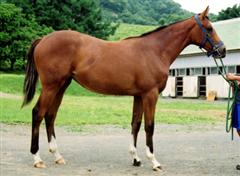Karabakh
N/A
Fri, 18th April, 2025 - 8:36 pm GMT
Sponsor Ads:

Alternative Name
N/ABasic Info
The horse is not large, 14-15 hands high or 145-150 cm. They have small clean-cut heads, straight profile with broad foreheads and nostrils very capable of dilation. Their neck is set high, average in length, muscular and elegant. They have compact bodies with well defined and developed muscles. The shoulders are often quite upright. The horses have a deep chest, a sloping croup, and long, fine, but very strong legs. They have thin skin and soft and gleaming hair. The colors of the breed are chestnut and bay, with characteristic golden tint. They can also be gray. White markings are allowed. The horses have a deep chest, a sloping croup, and long, fine, but very strong legs, although the joints are small. The horses are narrow, not very deep through the girth, due to the Akhal-Teke influence.
Health
N/AHabitat
N/ABehavior
Use : Racing, riding. Karabakh is a mountain-steppe racing and riding horse. It is named after the Karabakh region of Azerbaijan, part of which is currently under Armenian military control. The horse was originally developed in this region. These horses are noted for their good tempers and speed. In 2004 a Karabakh horse named Kishmish from Agdam stud in Azerbaijan made a record in speed by running 1000 meters in 1 minute, 9 seconds and 1600 meters in 1 minute, 52 seconds. As well as being fast and agile, Karabakh horse is reputed to have good temperaments: calm, willing, and brave. The breed is hardy, strong, tough, and sure-footed.Origin
AzerbaidzhanHistory
Been found in the mountains of Azerbaidzhan since the 5th century. Karabakh has close links to Akhal-Teke, bred in Turkmenistan, Central Asia and the Turkoman Horse bred in Iran. Some historians believe that in ancient times these horses were of the same strain and had significant influence in developing of the Arabian breed. Some historical sources mention that during Arab invasion of Azerbaijan in 8th-9th centuries tens of thousands of horses with golden-chestnut coloring, which is characteristic colors for Karabakhs, were taken by the conquerors. The breed got its ultimate shapes and characteristics in 18th-19th centuries during Karabakh khanate. There is some evidence that Karabakh ruler Ibrahim-Khalil khan (1763-1806) possessed a horse herd numbering 3,000-4,000, mostly of Karabakh breed. From 19th century this horse breed became increasingly popular in Europe. Thus, in one of the first massive sales in 1823, an English company purchased 60 pure Karabakh mares from Mehdi-Kulu khan, the last ruler of the Karabakh khanate. Karabakh numbers were initially hurt in 1826 during Russo-Iranian war, but the breed remained intact.Common Foods
grassSponsor Ads:
Admiration: Our polite recognition of another's resemblance to ourselves. --Ambrose Bierce
Karabakh
Coded by: BGID® | ALL RIGHTS RESERVED Copyright © 2000-2025
Disclaimer | Privacy | Report Errors / Contact | Credits








 Preparing For China. China is growing their military. China Military Technology - can it keep up with the US?
Preparing For China. China is growing their military. China Military Technology - can it keep up with the US?  versus
versus 

 versus
versus 
 This Thread is about the North Korean Military itself - the kind of army, navy, and air force they have.
This Thread is about the North Korean Military itself - the kind of army, navy, and air force they have. 
 versus
versus 
 versus
versus  versus
versus